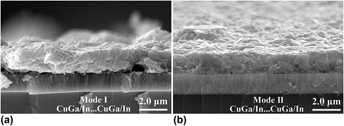No CrossRef data available.
Article contents
Optimization of Cu(In,Ga)Se2 formation by regulating the stacked metal layers structure-the role of metallic growth
Published online by Cambridge University Press: 12 December 2016
Abstract

The absorber layers for chalcopyrite solar cells were fabricated by selenization of the stacked metal layers (SML). Co-sputtering and sequential sputtering methods were utilized to prepare the SML, and the variation of the stacking sequences and the effect of each stacked layer thickness were investigated. The stacking sequence of In/CuGa⋯In/CuGa was found having advantages in the SML growth and the average size of indium hillocks might be tailored by changing the thickness of each stacked layer. The SML in the stacking mode of In/CuGa⋯In/CuGa prepared while the thickness for each indium layer fixed at approximately 83 nm exhibited the desired morphology with evenly distributed indium hillocks in small diameters. The selenized  ${\rm{CuI}}{{\rm{n}}_x}{\rm{G}}{{\rm{a}}_{1 - x}}{\rm{S}}{{\rm{e}}_2}$ (CIGS) layer showed a smooth surface and largest grain size with phase segregation being suppressed effectively. The hole mobility of the best CIGS layers reached 8.36 cm2/V s.
${\rm{CuI}}{{\rm{n}}_x}{\rm{G}}{{\rm{a}}_{1 - x}}{\rm{S}}{{\rm{e}}_2}$ (CIGS) layer showed a smooth surface and largest grain size with phase segregation being suppressed effectively. The hole mobility of the best CIGS layers reached 8.36 cm2/V s.
Keywords
Information
- Type
- Articles
- Information
- Copyright
- Copyright © Materials Research Society 2016


